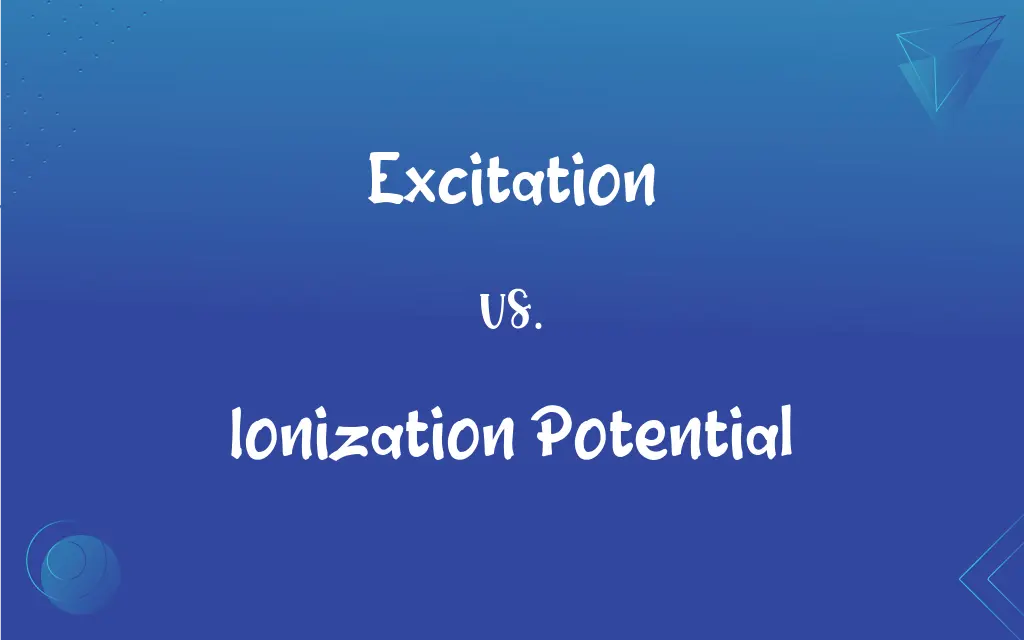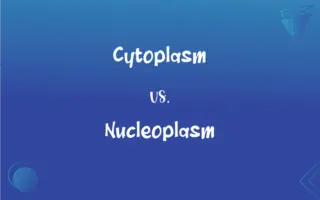Excitation vs. Ionization Potential: What's the Difference?
Edited by Aimie Carlson || By Harlon Moss || Updated on October 18, 2023
Excitation pertains to moving electrons to higher energy states within an atom; ionization potential is the energy needed to remove an electron from an atom.

Key Differences
Excitation involves promoting an electron to a higher energy level within an atom without removing it, while ionization potential quantifies the energy required to detach an electron entirely from that atom. Both relate to electron behavior but signify different phenomena.
In atomic structures, excitation typically results from absorbing energy, pushing an electron to a more energetic, yet still bound, state. Conversely, ionization potential designates the threshold energy to break the electron's atomic bond.
It's crucial to understand that excitation doesn't form ions since the electron remains a part of the atom. On the other hand, surpassing the ionization potential does form ions, as it implies the complete removal of an electron.
Visualize excitation as a person moving between floors in a building, while the ionization potential relates to the energy needed to push someone out of the building entirely. Both deal with movement, but their outcomes differ considerably.
Essentially, excitation and ionization potential both pertain to electron behaviors under energy influence. However, while excitation is about internal energy shifts, ionization potential focuses on the energy for electron ejection.
ADVERTISEMENT
Comparison Chart
Definition
Electron's movement to a higher energy state within an atom
Energy required to remove an electron from an atom
Results in
Electron in a higher but bound state
Formation of an ion
Energy Absorption
Partial, doesn't exceed ionization potential
At least equal to the atom's ionization potential
Electron's Fate
Remains within the atom
Exits the atom entirely
Outcome
No ion formation
Ion formation
ADVERTISEMENT
Excitation and Ionization Potential Definitions
Excitation
Response of an atom to absorbed energy.
The excitation of the gas in the tube caused it to glow.
Ionization Potential
Energy barrier to ion formation.
Understanding the ionization potential helps predict element behavior in reactions.
Excitation
Movement without ion formation.
The excitation of electrons in the metal did not cause them to leave the surface.
Ionization Potential
Threshold for forming ions.
The ionization potential of sodium determines its reactivity.
Excitation
Internal atomic energy adjustment.
The laser induced excitation in the atom, making it more energetic.
Ionization Potential
Atomic resistance to electron loss.
Noble gases have a high ionization potential due to their stable configurations.
Excitation
Result of energy intake without ionization.
The excitation of the molecule was evident in its emitted light spectrum.
Ionization Potential
Measure of electron detachment energy.
Elements with high ionization potential tend to be less reactive.
Excitation
Electron's shift to a higher energy state.
Upon absorbing light, the atom underwent excitation.
Ionization Potential
Energy to eject an electron from an atom.
Helium has a higher ionization potential than hydrogen.
Excitation
The act or process of exciting or an instance of it.
Excitation
The state or condition of being excited.
FAQs
Which relates to the atom's resistance to electron loss?
Ionization potential.
What does ionization potential quantify?
The energy needed to remove an electron from an atom.
Is ionization potential an energy threshold?
Yes, it's the energy required to ionize an atom.
Can an atom undergo excitation without forming ions?
Yes, excitation doesn't lead to ion formation.
Is excitation a permanent state for an electron?
No, electrons can return to their original energy state.
Which concept, excitation or ionization potential, relates to internal atomic energy adjustments?
Excitation.
What energy level do electrons move to during excitation?
A higher but still bound energy state within the atom.
Can an atom undergo multiple excitations?
Yes, electrons can move to various higher energy levels.
Which involves an electron moving to a higher energy level, excitation or ionization potential?
Excitation.
Can an atom have multiple levels of ionization potential?
Yes, corresponding to the removal of successive electrons.
What's a key difference between excitation and ionization potential outcomes?
Excitation doesn't form ions; exceeding ionization potential does.
Do elements with high ionization potential tend to be reactive?
No, they usually are less reactive.
Does ionization potential relate to atomic stability?
Yes, atoms with high ionization potentials typically have stable electron configurations.
Does excitation lead to the formation of ions?
No, it doesn't.
Which concept helps predict element reactivity in chemical reactions?
Ionization potential.
Is excitation a result of energy absorption?
Yes, typically from sources like light or heat.
Does surpassing the ionization potential result in an electron's complete ejection from an atom?
Yes, it does.
What's a common outcome when an atom exceeds its ionization potential?
The atom loses an electron and becomes an ion.
Does exceeding the ionization potential always lead to ion formation?
Yes, it implies the removal of an electron.
What happens to an electron during excitation?
It moves to a higher energy state within the atom.
About Author
Written by
Harlon MossHarlon is a seasoned quality moderator and accomplished content writer for Difference Wiki. An alumnus of the prestigious University of California, he earned his degree in Computer Science. Leveraging his academic background, Harlon brings a meticulous and informed perspective to his work, ensuring content accuracy and excellence.
Edited by
Aimie CarlsonAimie Carlson, holding a master's degree in English literature, is a fervent English language enthusiast. She lends her writing talents to Difference Wiki, a prominent website that specializes in comparisons, offering readers insightful analyses that both captivate and inform.































































